Quick Summary:
- Your website is your digital stage to get bookings.
- Include clear topics, a media kit, and easy booking.
- Optimize with SEO and maintain for ongoing success.
Table of Contents
- 1. The Compelling Speaker Website: Your Digital Stage
- 1.1 Why Every Speaker Needs a Stellar Website
- 1.2 The Anatomy of a High-Converting Speaker Website
- 2. Streamlining Bookings: The Power of an Integrated Booking Form
- 2.1 Why a Booking Form is Essential
- 2.2 Designing a User-Friendly Booking Form
- 2.3 Essential Fields for Your Booking Form
- 2.4 Integrating Your Booking Form with Your Website
- 3. The Power of a Media Kit Showcase: Making it Easy for Event Planners
- 3.1 Why a Media Kit Showcase is Crucial
- 3.2 Essential Elements of a Compelling Media Kit Showcase
- 3.3 Presentation and Accessibility of Your Media Kit Showcase
- 4. Optimizing Your Website for Search Engines (SEO)
- 4.1 Why SEO Matters for Speakers
- 4.2 Key SEO Strategies for Speakers
- 4.3 Local SEO for Speakers
- 5. Website Maintenance and Updates
- 5.1 Why Ongoing Maintenance is Essential
- 5.2 Key Website Maintenance Tasks
- 6. Leveraging Qrolic Technologies for Your Speaker Website
- 7. The Ultimate Checklist for Speaker Website Success
1. The Compelling Speaker Website: Your Digital Stage

1.1 Why Every Speaker Needs a Stellar Website
Imagine walking into a grand theater, ready to deliver your life-changing message, only to find the stage is a cluttered mess, the lighting is dim, and the sound system crackles with static. That’s what a poor website does to your reputation as a public speaker. Your website isn’t just an online brochure; it’s your digital stage, your first impression, and your 24/7 marketing machine. It’s the hub where potential clients, event organizers, and even future fans come to decide if you’re worth their time and investment. Without a compelling speaker website, you’re essentially whispering your message into the void.
-
Establishing Credibility & Authority: A professional, well-designed website instantly boosts your credibility. It showcases your expertise, experience, and thought leadership. Think of it as your digital resume, but with personality and passion.
-
Generating Leads & Bookings: Your website is a powerful lead generation tool. By strategically incorporating calls to action (CTAs) and a user-friendly booking form, you can convert website visitors into paying clients.
-
Controlling Your Narrative: In a world of social media noise, your website allows you to control your narrative. You decide what information is presented, how it’s presented, and what message you want to convey.
-
Building Your Brand: Your website is an extension of your brand. It should reflect your personality, values, and unique selling proposition (USP). Consistent branding across your website, social media, and speaking engagements reinforces your message and makes you more memorable.
1.2 The Anatomy of a High-Converting Speaker Website
A great speaker website isn’t just pretty; it’s strategically designed to achieve specific goals: attracting the right audience, showcasing your expertise, and driving bookings. Let’s break down the essential elements:
Homepage: Your Digital Elevator Pitch
- Compelling Headline: Grab attention instantly with a headline that clearly communicates your value proposition. What problems do you solve? What results do you deliver?
- High-Quality Hero Image or Video: A visually appealing image or video of you speaking on stage, engaging with an audience, or delivering a powerful message can make a huge impact.
- Concise Value Proposition: Clearly articulate what you offer in a few short sentences. Focus on the benefits for the audience or event organizer, not just features.
- Prominent Call to Action (CTA): Tell visitors what you want them to do next. “Book Me for Your Event,” “Download My Speaker Kit,” or “Watch My Demo Reel” are all effective CTAs.
- Social Proof: Include testimonials, logos of past clients, and media mentions to build trust and credibility.
- Easy Navigation: Ensure your website is easy to navigate with a clear menu and intuitive layout.
About Page: Tell Your Story
- Authentic Voice: Write in your own voice and share your personal story. Why are you passionate about speaking? What experiences have shaped your expertise?
- Focus on the Audience: While the “About” page is about you, frame it in terms of how your experiences and expertise benefit your audience.
- Professional Headshot: A high-quality headshot conveys professionalism and approachability.
- Brief Bio: Summarize your key accomplishments, credentials, and experience in a concise bio.
- Connection Points: Encourage visitors to connect with you on social media or sign up for your newsletter.
Speaking Topics Page: Showcase Your Expertise
- Clear and Concise Descriptions: Provide detailed descriptions of your speaking topics, highlighting the key takeaways for the audience.
- Target Audience: Specify the ideal audience for each speaking topic. This helps event organizers determine if you’re a good fit.
- Benefits-Oriented Language: Focus on the benefits of your presentation for the audience, such as increased engagement, improved performance, or new insights.
- Visual Aids: Use images or videos to illustrate your speaking topics and engage visitors.
- Testimonials Specific to Each Topic: If you have testimonials that specifically address a particular speaking topic, include them on that page.
Media Kit Showcase: Make it Easy to Book You
- Centralized Hub: Your media kit should be a centralized hub containing all the information event organizers need to book you.
- Downloadable Resources: Make it easy for event organizers to download your headshots, bio, speaker rider, and other essential materials.
- High-Resolution Photos: Include a variety of high-resolution photos that event organizers can use in their promotional materials.
- Speaker Rider: Clearly outline your technical requirements, travel arrangements, and other logistical details.
- Video Demo Reel: A professionally produced demo reel is crucial for showcasing your speaking style and stage presence.
- One-Sheet: A concise one-page summary of your key information, speaking topics, and contact details.
Blog: Establish Thought Leadership and Drive Traffic
- Relevant and Engaging Content: Write blog posts that are relevant to your speaking topics and audience interests.
- SEO Optimization: Optimize your blog posts for search engines using relevant keywords.
- Consistent Posting Schedule: Regularly publish new content to keep your website fresh and engaging.
- Call to Action: Include a call to action at the end of each blog post, encouraging visitors to book you, download a resource, or sign up for your newsletter.
- Shareable Content: Make it easy for visitors to share your blog posts on social media.
Contact Page: Make it Easy to Connect
- Clear Contact Information: Provide your email address, phone number, and social media links.
- Contact Form: Include a contact form for visitors to easily send you messages.
- Location (if applicable): If you have a physical office or studio, include your address on the contact page.
- Prompt Response Time: Respond to inquiries promptly and professionally.
2. Streamlining Bookings: The Power of an Integrated Booking Form
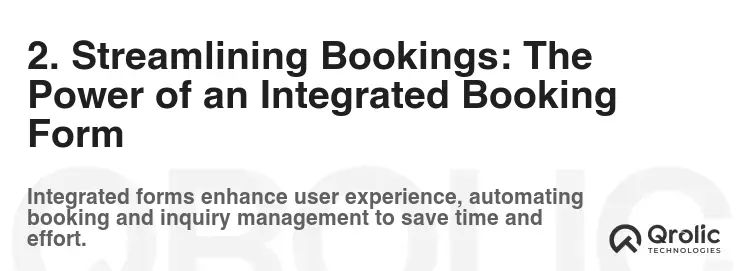
2.1 Why a Booking Form is Essential
Imagine a potential client is excited about hiring you after browsing your website. They’re ready to book, but instead of a clear path, they’re faced with a confusing email chain, phone tag, and uncertainty. That’s a booking opportunity lost. A well-designed booking form streamlines the process, making it easy for event organizers to book you and reducing the likelihood of drop-off. It demonstrates professionalism, saves time, and ultimately, increases your bookings.
-
Efficiency and Convenience: A booking form allows event organizers to submit all the necessary information in one place, eliminating the need for multiple emails or phone calls.
-
Lead Qualification: By asking specific questions in the booking form, you can qualify leads and ensure that you’re a good fit for the event.
-
Data Collection: The booking form collects valuable data about your potential clients, which you can use to personalize your communication and tailor your services.
-
Reduced Administrative Overhead: A booking form automates the booking process, freeing up your time to focus on other aspects of your business.
2.2 Designing a User-Friendly Booking Form
A great booking form is intuitive, easy to use, and gathers all the essential information you need to evaluate and accept speaking engagements. Here’s a breakdown of key considerations:
-
Keep it Concise: Only ask for the information you absolutely need. A lengthy, complicated form can deter potential clients.
-
Clear and Concise Questions: Use clear and concise language that is easy to understand.
-
Required Fields: Clearly indicate which fields are required.
-
Dropdown Menus and Checkboxes: Use dropdown menus and checkboxes to provide pre-defined options and make it easier for users to select their answers.
-
Mobile-Friendly Design: Ensure that your booking form is mobile-friendly, as many event organizers will be accessing it on their smartphones or tablets.
-
Confirmation Message: Display a confirmation message after the form is submitted, letting the user know that their request has been received.
2.3 Essential Fields for Your Booking Form
Event Details:
- Event Name: The name of the event.
- Event Date(s): The date or dates of the event.
- Event Location: The city, state, and venue of the event.
- Event Type: (e.g., Conference, Workshop, Corporate Event) Use a dropdown menu for common event types.
- Target Audience: A description of the target audience for the event.
- Expected Attendance: The estimated number of attendees.
Speaking Engagement Details:
- Desired Speaking Topic: A dropdown menu of your available speaking topics.
- Desired Speaking Length: The desired length of your presentation.
- Key Objectives: What are the main objectives for your presentation? What do you want the audience to take away?
- Budget: What is the budget for the speaker? (This can be a range or a specific number).
Contact Information:
- Contact Name: The name of the person responsible for booking the speaker.
- Organization: The organization or company the contact represents.
- Email Address: The contact’s email address.
- Phone Number: The contact’s phone number.
Additional Information:
- Anything Else We Should Know?: An open text field for the event organizer to provide any additional information.
- How Did You Hear About Me?: Understanding how potential clients found you helps you optimize your marketing efforts.
2.4 Integrating Your Booking Form with Your Website
There are several ways to integrate a booking form with your website:
-
Embedded Form: Embed the booking form directly into your website using a plugin or code snippet.
-
Link to External Form: Link to an external booking form hosted on a platform like Jotform, Typeform, or Google Forms.
-
Dedicated Booking Page: Create a dedicated page on your website specifically for the booking form.
3. The Power of a Media Kit Showcase: Making it Easy for Event Planners
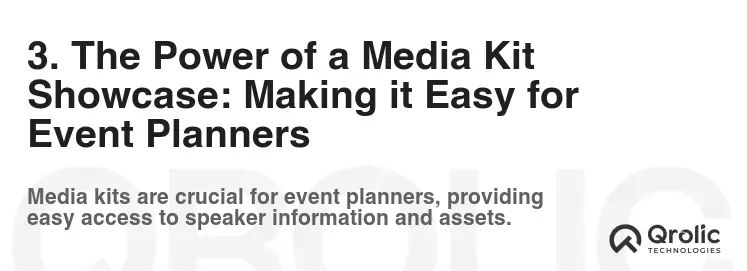
3.1 Why a Media Kit Showcase is Crucial
Imagine you’re an event planner, frantically searching for the perfect speaker. You’ve found a few promising candidates, but their websites are a mess. You can’t find their headshots, their bio is buried deep in the “About” page, and you have no idea what their technical requirements are. You’re likely to move on to the next speaker. A well-organized and easily accessible Media Kit Showcase solves this problem. It’s a dedicated section of your website that provides event planners with everything they need to evaluate and book you, saving them time and making you look incredibly professional. It streamlines the booking process and drastically increases your chances of getting hired.
-
Professionalism and Credibility: A comprehensive media kit showcases your professionalism and attention to detail.
-
Convenience for Event Organizers: It provides event organizers with all the information they need in one convenient location.
-
Brand Consistency: It ensures that event organizers have access to the correct branding materials, such as your logo and headshots.
-
Time Savings: It saves event organizers time by providing them with all the information they need upfront, eliminating the need for back-and-forth communication.
3.2 Essential Elements of a Compelling Media Kit Showcase
High-Resolution Headshots:
- Variety of Options: Include a variety of headshots in different styles and poses.
- Professional Quality: Ensure that your headshots are professionally taken and high-resolution.
- Downloadable Formats: Provide your headshots in various downloadable formats, such as JPEG and PNG.
Professional Biography (Short and Long Versions):
- Short Bio: A concise bio of 50-100 words for use in event programs and promotional materials.
- Long Bio: A more detailed bio of 200-300 words for use on your website and in longer publications.
- Focus on Key Accomplishments: Highlight your key accomplishments, credentials, and experience.
Speaking Topics Overview:
- Brief Descriptions: Provide brief descriptions of your speaking topics, highlighting the key takeaways for the audience.
- Target Audience: Specify the ideal audience for each speaking topic.
- Visual Aids: Use images or videos to illustrate your speaking topics.
Demo Reel (Video):
- High-Quality Production: Invest in a professionally produced demo reel that showcases your speaking style and stage presence.
- Engaging Content: Include excerpts from your best presentations, testimonials, and audience reactions.
- Clear Audio and Video: Ensure that your demo reel has clear audio and video quality.
Client Testimonials:
- Variety of Industries: Include testimonials from a variety of industries and event types.
- Specific and Quantifiable Results: Choose testimonials that highlight specific and quantifiable results.
- Video Testimonials: Video testimonials are even more powerful than written testimonials.
Speaker Rider:
- Technical Requirements: Clearly outline your technical requirements, such as audio-visual equipment, stage setup, and lighting.
- Travel Arrangements: Specify your travel requirements, such as transportation, accommodation, and meals.
- Hospitality: Outline any hospitality requests, such as a green room, snacks, and beverages.
Social Media Links:
- Prominent Display: Make it easy for event organizers to find and follow you on social media.
- Active Profiles: Ensure that your social media profiles are active and up-to-date.
Contact Information:
- Email Address: Provide a professional email address.
- Phone Number: Include a phone number for inquiries.
3.3 Presentation and Accessibility of Your Media Kit Showcase
- Dedicated Page: Create a dedicated page on your website specifically for your media kit.
- Clear Navigation: Make it easy for event organizers to find the media kit from your homepage.
- Downloadable Files: Provide all the materials in downloadable formats, such as PDF, JPEG, and PNG.
- Organized Layout: Organize the materials in a clear and logical layout.
- Mobile-Friendly Design: Ensure that your media kit is mobile-friendly.
4. Optimizing Your Website for Search Engines (SEO)

4.1 Why SEO Matters for Speakers
Imagine you’re an event organizer searching on Google for a “motivational speaker for sales teams.” If your website isn’t optimized for search engines, it won’t appear in the search results, and you’ll miss out on potential bookings. SEO (Search Engine Optimization) is the process of improving your website’s visibility in search engine results pages (SERPs) like Google, Bing, and Yahoo. It’s crucial for attracting organic traffic (traffic that comes from search engines) to your website and increasing your chances of getting hired. Without SEO, you’re relying solely on word-of-mouth and paid advertising, which can be expensive and less effective.
-
Increased Visibility: SEO helps your website rank higher in search engine results, making it easier for potential clients to find you.
-
Targeted Traffic: SEO allows you to attract visitors who are specifically searching for speakers in your niche.
-
Cost-Effective Marketing: SEO is a cost-effective marketing strategy compared to paid advertising.
-
Long-Term Results: SEO can provide long-term results, driving traffic to your website for months or even years.
4.2 Key SEO Strategies for Speakers
-
Keyword Research: Identify the keywords that your target audience is using to search for speakers. Use tools like Google Keyword Planner, SEMrush, or Ahrefs to find relevant keywords with high search volume and low competition. Focus on keywords related to your speaking topics, industry, and location.
On-Page Optimization:
- Title Tags: Optimize your title tags with relevant keywords.
- Meta Descriptions: Write compelling meta descriptions that accurately describe the content of each page and encourage users to click through.
- Header Tags (H1-H6): Use header tags to structure your content and highlight important keywords.
- Image Alt Text: Add alt text to your images, describing what the image is about and including relevant keywords.
- Content Optimization: Create high-quality, informative, and engaging content that is optimized for your target keywords.
Off-Page Optimization:
- Link Building: Build high-quality backlinks from other websites. Guest blogging, industry directories, and social media promotion are all effective link-building strategies.
- Social Media Marketing: Promote your website and content on social media.
- Online Reputation Management: Monitor your online reputation and respond to reviews and comments.
Technical SEO:
- Website Speed: Ensure that your website loads quickly.
- Mobile-Friendliness: Make sure your website is mobile-friendly.
- Website Security (HTTPS): Secure your website with HTTPS.
- XML Sitemap: Submit an XML sitemap to search engines.
- Robots.txt File: Create a robots.txt file to tell search engines which pages to crawl.
4.3 Local SEO for Speakers
If you primarily speak in a specific geographic area, local SEO is crucial.
- Google My Business Listing: Create and optimize your Google My Business listing.
- Local Citations: List your business in local directories, such as Yelp, Yellow Pages, and TripAdvisor.
- Local Keywords: Target local keywords in your website content.
- Get Reviews: Encourage clients to leave reviews on Google and other review sites.
5. Website Maintenance and Updates
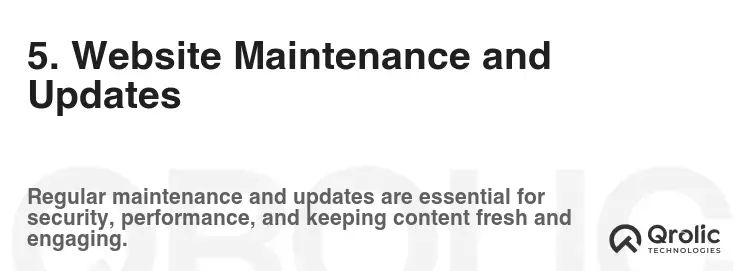
5.1 Why Ongoing Maintenance is Essential
Your website isn’t a static brochure; it’s a living, breathing marketing asset that requires ongoing maintenance and updates. Neglecting your website can lead to broken links, outdated information, security vulnerabilities, and a poor user experience, all of which can damage your reputation and negatively impact your bookings. Regular maintenance ensures that your website is functioning properly, secure, and up-to-date with the latest trends.
- Security: Protect your website from hackers and malware.
- Performance: Ensure that your website loads quickly and performs optimally.
- User Experience: Provide a positive user experience for your visitors.
- SEO: Maintain your website’s SEO ranking.
- Content Freshness: Keep your website content up-to-date and relevant.
5.2 Key Website Maintenance Tasks
- Software Updates: Regularly update your website’s software, including your content management system (CMS), plugins, and themes.
- Security Scans: Run regular security scans to identify and fix vulnerabilities.
- Backup Your Website: Back up your website regularly in case of data loss.
- Check for Broken Links: Identify and fix broken links.
- Update Content: Keep your website content up-to-date and relevant.
- Monitor Website Analytics: Track your website traffic and performance.
- Test Your Website: Regularly test your website on different devices and browsers.
6. Leveraging Qrolic Technologies for Your Speaker Website
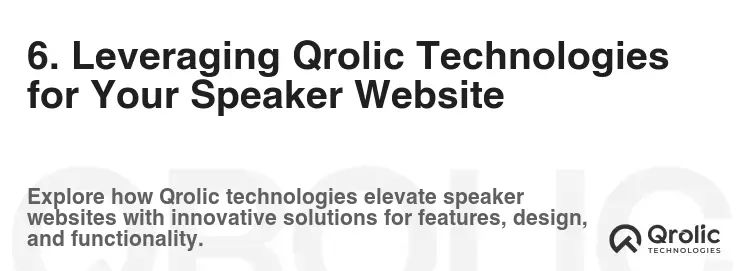
Qrolic Technologies offers a comprehensive suite of services to help public speakers create and maintain high-performing websites. From custom web design and development to SEO optimization and ongoing maintenance, Qrolic Technologies can help you build a website that attracts the right audience, showcases your expertise, and drives bookings.
Here’s how Qrolic Technologies can help:
-
Custom Website Design: Qrolic Technologies will create a custom website design that reflects your brand, personality, and speaking style. They understand the specific needs of public speakers and will ensure that your website includes all the essential features, such as a compelling homepage, an engaging “About” page, a comprehensive media kit showcase, and a user-friendly booking form.
-
SEO Optimization: Qrolic Technologies’ SEO experts will optimize your website for search engines, helping you rank higher in search results and attract more organic traffic. They will conduct keyword research, optimize your website content, build high-quality backlinks, and ensure that your website is technically sound.
-
Website Maintenance and Support: Qrolic Technologies offers ongoing website maintenance and support services to ensure that your website is secure, up-to-date, and performing optimally. They will handle software updates, security scans, backups, and other essential maintenance tasks, freeing up your time to focus on your speaking engagements.
-
E-commerce Integration: If you sell products or services on your website, Qrolic Technologies can integrate e-commerce functionality, allowing you to accept payments, manage orders, and track sales.
-
Content Creation: Need help creating compelling website content? Qrolic Technologies offers content creation services, including blog posts, website copy, and social media content.
Investing in a professionally designed and maintained website is an investment in your speaking career. Qrolic Technologies can help you create a website that is not only visually appealing but also strategically designed to achieve your business goals.
7. The Ultimate Checklist for Speaker Website Success
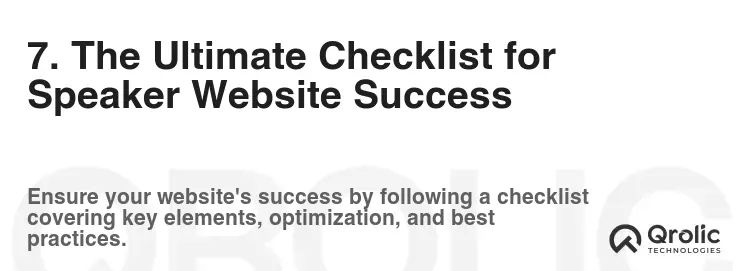
Use this checklist to ensure your website is optimized for success:
Homepage:
- [ ] Compelling headline
- [ ] High-quality hero image or video
- [ ] Concise value proposition
- [ ] Prominent call to action (CTA)
- [ ] Social proof (testimonials, logos, media mentions)
- [ ] Easy navigation
About Page:
- [ ] Authentic voice
- [ ] Focus on the audience
- [ ] Professional headshot
- [ ] Brief bio
- [ ] Connection points (social media links, newsletter signup)
Speaking Topics Page:
- [ ] Clear and concise descriptions
- [ ] Target audience specified
- [ ] Benefits-oriented language
- [ ] Visual aids
- [ ] Testimonials specific to each topic
Media Kit Showcase:
- [ ] High-resolution headshots
- [ ] Professional biography (short and long versions)
- [ ] Speaking topics overview
- [ ] Demo reel (video)
- [ ] Client testimonials
- [ ] Speaker rider
- [ ] Social media links
- [ ] Contact information
Booking Form:
- [ ] Clear and concise questions
- [ ] Required fields indicated
- [ ] Dropdown menus and checkboxes used
- [ ] Mobile-friendly design
- [ ] Confirmation message displayed
Blog:
- [ ] Relevant and engaging content
- [ ] SEO optimization
- [ ] Consistent posting schedule
- [ ] Call to action
- [ ] Shareable content
SEO:
- [ ] Keyword research conducted
- [ ] On-page optimization completed (title tags, meta descriptions, header tags, image alt text, content optimization)
- [ ] Off-page optimization efforts in place (link building, social media marketing, online reputation management)
- [ ] Technical SEO addressed (Website Speed, mobile-friendliness, website security, XML sitemap, robots.txt file)
- [ ] Local SEO optimized (Google My Business listing, local citations, local keywords, reviews)
Website Maintenance:
- [ ] Software updates performed regularly
- [ ] Security scans conducted
- [ ] Website backed up regularly
- [ ] Broken links checked and fixed
- [ ] Content updated regularly
- [ ] Website analytics monitored
- [ ] Website tested on different devices and browsers
By implementing these strategies and regularly maintaining your website, you can create a powerful online presence that helps you attract more clients, build your brand, and achieve your speaking goals.






